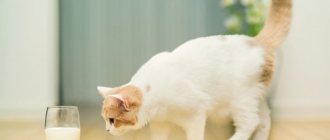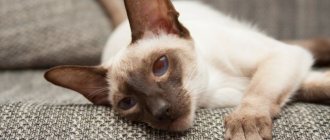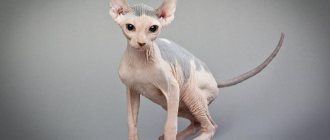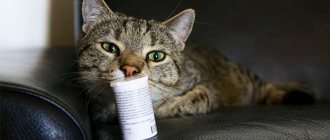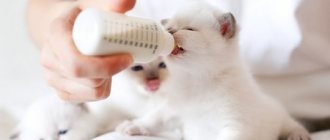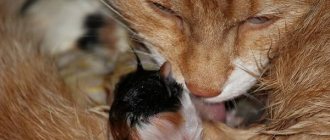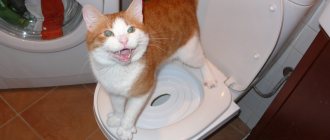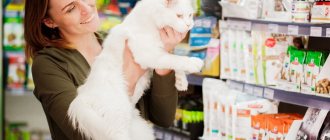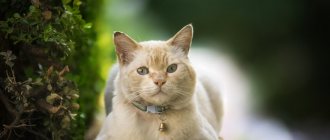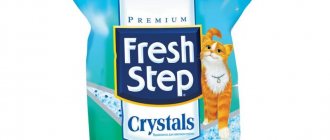Milk in the diet of kittens
At least until 2 months, the kitten's main food product is mother's milk. It contains all the elements necessary for intensive growth and development and provides immune protection for the baby’s body.
If for some reason the kitten is left without mother's milk, the only complete source of replacement can only be special dry formulas sold in specialized pet salons. For example, Beaphar Kitty-Milk or Royal Canin Babycat Milk.
In the absence of special mother's milk substitutes, you can give the kitten infant formula or goat's milk for a short time. Whole cow's milk is not a complete and correct substitute and can be harmful to the baby.
This drink was originally created by nature for feeding calves. Despite the fact that it contains many useful substances and amino acids, it also contains components that are not intended for the cat's body.
Cow's milk proteins are very poorly absorbed by kittens. In addition, store-bought milk is obtained from cows whose diet is based on industrial feed, so the content of pesticides and antibiotics in the drink will be very high.
Much higher than the permissible standards for the cat's body in cow's milk and casein with lactose. They are also difficult for small kittens to digest.
Goat's milk, although not such a complete replacement as mother's milk, is much closer to it in composition. It is only advisable to dilute it with boiled water to reduce fat content.
When purchasing a special cat's mother's milk substitute at a pet store, you should consider:
- Manufacturer's brand. It is advisable to choose only those that have good reviews from veterinarians and cat nutritionists.
- Breed of the kitten. For example, Maine Coons, Pixie Bobs, and some other varieties need more high-calorie nutrition.
- Fat content of the mixture. Ideally, it should not exceed 9%.
If the kitten is bottle-fed, after a month you can slowly introduce meat purees into its menu; by 2-3 months, milk should no longer be the main dish in the baby’s daily diet.
And by six months, this drink must be completely excluded from the kittens’ diet or replaced with another product, for example, kefir, since as cats grow older they lose the ability to absorb milk sugar.
Frequency factors for fluid intake
The amount of fluid consumed depends on many factors: type of food, ambient temperature, individual characteristics of the pet, conditions of its keeping.
Moisture content of the animal's diet
How to train a kitten to use a litter box: options in 1 day and choice of filler
A kitten feeding on mother's milk does not need additional water. Wet food, pates, stews contain up to 80% liquid, this amount is enough to maintain life. If the owner feeds the pet natural products, then it is not surprising that the cat drinks little. She gets moisture from milk, kefir, eggs, and vegetables.
Some recommendations apply to cats eating dry food. The amount of liquid required should exceed the weight of the granules by 3 times. If a kitten eats 50g of dry food, it will need 150ml of liquid. Only if you follow these recommendations, concentrated feed will not cause harm to your health. With a lack of fluid, the kitten loses its playfulness and mobility.
Note! When eating protein foods, the amount of fluid consumed increases. Carbohydrate products are broken down into water during metabolism, so your pet may not feel thirsty. Salt-free feed reduces water consumption by animals.
Ambient temperature
Dry and warm air causes thirst, so in hot weather the cat needs additional moisture. In cold weather, water needs decrease.
Types of milk in a cat's diet
The most popular types of milk that owners can offer their pets are cow's and goat's.
Their comparative composition is given in the table.
| Index | Cow's milk | Goat milk |
| Fat content | 2,2 – 6,8 % | Average 4.5% |
| Vitamins | A; B1; B2; B6; B12; D; C. | A, D, E, C, B1, B2, B4, B5, B6, B12, H, PP, nicotinic acid. |
| Microelements | Calcium, potassium, phosphorus. | Calcium, potassium, phosphorus, magnesium, sodium, molybdenum. |
| Lactose content | High. | Minimal. |
| Calorie content, ml/100 g | 60 | 68 |
Despite the fact that goat milk has a high fat content, its composition is basically similar to cat and human breast milk, it contains more proteins, micro- and macroelements, and higher calorie content. At the same time, there is practically no alpha lipase, which causes the formation of fatty deposits.
Therefore, goat's milk is much preferable in pet nutrition than cow's milk:
- easier to digest;
- contains many lacto- and bifidobacteria, which improve digestion and gastrointestinal function;
- hypoallergenic, as it contains no proteins;
- minimal lactose content;
- lots of vitamins and minerals.
Milk tolerance and breed
Why can't Scottish cats have milk? Or Siamese? Or Persian? Does lactose tolerance or intolerance depend on the breed? No way. The physiology of all cats is the same. The Scottish cat's body may lack the necessary enzyme. And just one bowl of milk will cause diarrhea.
To find out whether your purebred pet can eat this tasty product, you will have to find out at random. As described above: offer some milk and observe the consequences.
Speaking of fold-eared cats. Some breeders scare owners that they should not give milk to fold-eared kittens. After all, it contains so much calcium that it can make your ears stand up. That's bullshit. Ear position is determined by genetics, not milk.
Then why can’t you give milk to fold-eared cats and kittens? For the same reason as usual. Due to the possible lack of the necessary enzyme in the body.
It is better to offer your purebred pet milk substitutes: natural yogurt without additives or low-fat kefir.
Is milk acceptable in the diet of an adult cat - benefit or harm?
Veterinarians and nutritionists advise excluding milk from a cat’s diet from 6 months, and some experts suggest doing this earlier - as early as 4 months.
This is due to the fact that this product contains a special element in huge concentration - milk sugar. Its breakdown is carried out in the cat's body under the influence of the enzyme lactose.
The body of any mammal produces quite a lot of it in infancy and childhood and produces practically none at all in adulthood.
The consequence of feeding an adult cat milk, especially cow's milk, is a malfunction of the gastrointestinal tract, the occurrence of dyspeptic symptoms - nausea, vomiting, diarrhea.
This theory is confirmed by almost all experts - product rejection occurs in most individuals, but there are exceptions to the rule.
Some adult and even elderly pets happily drink milk without any consequences for the proper functioning of the body. This is due to the individual characteristics of specific individuals. This means that it is in their body that a lot of lactose is still produced and the breakdown of milk sugars occurs successfully.
All adult animals like the taste of milk, but numerous studies have confirmed that it does not bring any benefit to the pet. Some cats, even in the absence of dyspeptic symptoms, may develop an allergic reaction when feeding them milk.
Thus, despite the assertion of some scientists about the indispensability of cow's milk in the diet of cats, most experts recognize this product as harmful and unacceptable in the diet of adult pets:
- The high calorie content of milk can lead to imbalance in the body and ultimately lead to obesity.
- The high content of casein and lactose does not allow the product to be completely absorbed.
- An extremely high concentration of elements that are unacceptable in the diet of an adult animal contributes to the development of allergies.
- Intolerance to milk sugars by the cat's body leads to indigestion, flatulence, bloating, indigestion, chronic diarrhea and dehydration.
What's wrong with milk?
We've covered why cats can't have milk. Now let's talk about some interesting facts related to this product.
- Today there is a huge selection of milk in stores. But is the packaged product useful? You can hardly treat them to a cat. The fact is that most of the products presented come from cows that are fed with hormones and other chemicals. This is done for various reasons: to increase milk production, to improve growth, due to diseases. And what is the use of such a “cocktail”?
- Sometimes pesticides and other harmful substances may be found in milk.
- Milk that goes on sale is pasteurized. At least some of it. This is done in order to kill pathogenic bacteria. But along with the bacteria, the beneficial properties of the product are also killed. Some elements are destroyed, such as calcium. It is more difficult for a cat's body to digest such milk.
- Milk contains casein. And it can provoke allergies in your pet.
Compatibility of milk with dry food
Another question that concerns owners of animals that consume milk is its compatibility with dry formulas.
Ready-made industrial food is a completely balanced product containing all the necessary elements, and there is no need for your cat to drink it with milk.
With the simultaneous intake of milk and dry formulas, an excess of nutrients and microelements appears in the cat’s body, which settle in the form of deposits on the walls of the bladder and kidneys, leading to the development of urolithiasis. The liver also suffers, since this protective barrier of the body is filled with toxins. This product is especially dangerous for castrated cats and sterilized females.
Pets should drink food only with clean running water.
Cow's milk, even if replaced with goat's milk, which is less dangerous for cats, is an element of natural nutrition, and mixing it with feeding dry industrial food, according to veterinarians, is unacceptable.
How to tell if your cat is lactose intolerant
If your pet prefers to enjoy milk from time to time, but has not noticed any problems with its absorption, you can slightly diversify the cat’s diet. Most often, owners treat unsterilized domestic cats with cow's and goat's milk; less often, they give their pets store-bought milk or even dry diluted milk.
Goat's milk is a product high in riboflavin (vitamin B2), vitamin B1 and vitamin A. It is low in fat and is easier and faster absorbed by the cat's body. It has been established that intolerance to the proteins contained in goat's milk occurs much less frequently in animals. Sheep milk has approximately the same properties.
Cow
Cow's milk is a high-calorie product with high nutritional value. It is allowed to treat representatives of the cat family with it only if the animals do not have intolerance to the protein contained in this product.
Shop
Store-bought milk from a carton is one of the few products that not every cat will drink. Both in terms of nutritional value and taste characteristics, a store-bought product usually loses to natural milk. However, it is allowed to occasionally treat an animal to it (of course, if it does not have lactose intolerance).
To answer the question whether a kitten can be given milk, you need to understand how its digestion works. From a scientific point of view, cats fall into the following categories:
- Class: Mammals;
- Squad: Predatory;
- Family: Felines.
Nature has provided that the best nutrition for a newborn kitten is its mother's milk. A mother cat, like a true mammal, feeds her babies with milk for up to 3 months. During this time, a special enzyme, lactase, is produced in the kittens’ small intestine, which allows them to digest lactose (milk sugar).
When the kitten is 1 month old, the mother begins to gradually introduce him to solid food. They try meat, but breastfeeding does not stop. We must not forget: cats are predators. The kitten's body is growing and preparing for adulthood. Instead of lactase, proteases begin to be produced - enzymes responsible for the breakdown of proteins.
By 3 months, the cat has finished breastfeeding the kitten, and it can be given meat food. Lactase is no longer produced because there is no need for milk.
Note: in very rare cases, the gastrointestinal tract of adult animals may retain the ability to produce small amounts of lactase and digest milk.
The following mechanism works in the cat’s body: she drinks milk, but lactose is not broken down by lactase and passes through the small intestine undigested. Next, milk sugar attracts water and ends up in the large intestine, where bacteria try to process it. At this time, carbon dioxide, hydrogen and other substances that cause fermentation are released.
If your cat tolerates milk well and will never refuse it, even after listening to a lecture on lactose, calculate its daily intake of this treat: 10-15 ml per 1 kg of weight. If your cat doesn’t digest cow’s milk well, but the desire to pamper her with something delicious is irresistible, buy low-lactose milk from cat food manufacturers.
Important: dry cat food can only be combined with water. Do not try to diversify your “dry” diet with milk - this can lead to the formation of deposits in the bladder and kidneys, increased stress on the liver and other organs
If your pet eats “natural” food, you can treat her with fermented milk products. Give preference to low-fat cottage cheese, sour cream, fermented baked milk and kefir. Cheese should be low fat and unsalted
Pay attention to your pet’s well-being - let the treats bring only benefits!
After weaning from the mother, cats stop producing the lactase enzyme. Accordingly, the cat’s body stops absorbing milk normally. If you give dairy products to a cat, intestinal problems may appear, namely: diarrhea, bloating, and sometimes even vomiting. Most adult cats cannot digest lactose and cause discomfort for your pet.
Replacing milk with fermented milk products
If the cat is a dairy lover and is on a natural diet, it is better to gradually replace this product with a fermented milk menu.
Kefir, fermented baked milk, natural yoghurts not only do not contain milk sugars, but are also enriched with lactic acid bacteria, which have a beneficial effect on digestion and the functioning of the entire gastrointestinal system of the cat as a whole.
There is no lactose in these products; it is what is converted into lactic acid during fermentation.
Using various types of fermented milk products, you can regulate and eliminate intestinal problems in your pet. So, for example, in case of regular constipation, fresh kefir will help, and in case of diarrhea, “old” (two-day old) kefir.
You can offer your cat milk without or with low lactose content, but usually such products do not delight your pet.
When choosing kefir, or better yet biokefir or fermented baked milk, you should pay attention to the fat content in them. It shouldn't be high. That is why you should not often offer your cat high-calorie cottage cheese or cheese, much less sour cream.
It is unacceptable to feed your pet sweet yoghurts and curds containing a lot of sucrose. Sugar is another harmful and dangerous human product for cats.
Are there any substitutes?
We found out why cats can't have milk. Because of milk sugar, which individual organisms cannot cope with.
How to replace a tasty product? There is special milk that does not contain lactose. But it is very difficult to get it in Russia. Therefore, you will have to look for a replacement on the shelves of our stores. You can offer your pet kefir 1% fat, yogurt without additives, sour cream. All these products are given in small quantities and not very often.
Reviews from veterinarians
Thus, the opinion of most veterinarians boils down to the following:
- It is not forbidden to feed your pets milk if it is normally absorbed by his body. But you should not give them this product in melted form (high fat content), cream and condensed milk.
- It is recommended to cook porridge in water, even semolina.
- The rest of the cats can be given low-fat and unsweetened fermented milk products, again, provided that they accept it normally.
But these products are under no circumstances mixed with ready-made industrial feed.
With a natural diet, the amount of dairy or fermented milk products per day should not exceed 20-30% of the daily diet, because a cat is primarily a predator. And her diet should be dominated by animal proteins, specifically meat. This is the best treat for any pet.
Let's summarize
The purpose of the article is to clearly answer the question: why cats cannot have milk. Let's highlight the main aspects.
- Most cats suffer from milk sugar (lactose) intolerance.
- The product can cause diarrhea in a cat.
- Cow's milk differs in properties and composition from cat's milk, so it has no benefit for kittens.
- You can replace milk with natural yogurt, low-fat kefir or sour cream.
- Milk supplied for sale may contain residues of drugs used to treat the cow. Or hormonal drugs that are administered to animals on farms to improve something.
- Another disadvantage of milk is casein. It causes allergies in some felines.
- What do veterinarians say about this? It all depends on the animal’s body. If your cat tolerates milk, give it a little at a time, if not, look for a replacement.
